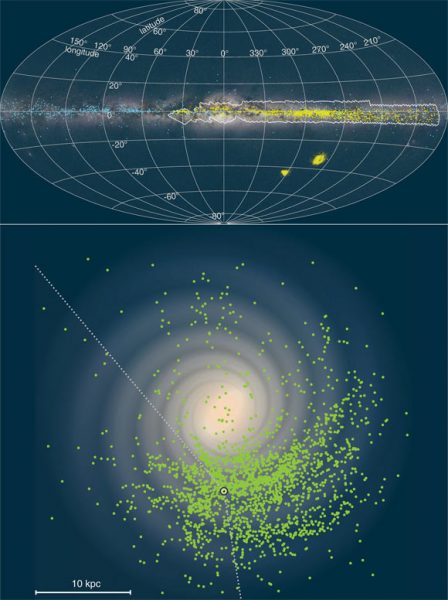Astronomers Create New 3D Map of Milky Way Galaxy | Astronomy – Sci-News.com
By measuring the distance from the Sun to thousands of classical Cepheid stars and the associated young stellar populations scattered across the Milky Way, astronomers have charted our Galaxy on a larger scale than ever before. The new 3D map, described in a paper in the journal Science, demonstrates the warping of the Milky Way’s disk.

Distribution of Galactic classical Cepheids. Top: on-sky view of the Milky Way in galactic coordinates, with the team’s sample of classical Cepheids in the Milky Way and in the Magellanic Clouds. Cepheids from the OGLE project are shown with yellow dots, other sources with cyan dots. Bottom: face-on view of our Galaxy with all 2,431 Cepheids in the sample marked with green dots. The background image represents a four-arm spiral galaxy model consistent with neutral hydrogen measurements in our Galaxy. The Sun is marked with a yellow dot. Image credit: Serge Brunier / ESO / Skowron et al, doi: 10.1126/science.aau3181.
Cepheid variable stars pulsate, causing their brightness to vary with periods of one to 100 days.
Classical Cepheids are young — less than 400 million years old — supergiant stars, whereas other types of Cepheids arise in older groups of stars.
The intrinsic luminosities of classical Cepheids span the range of 100 to 10,000 solar luminosities. This is bright enough to be detected within our Galaxy through obscuring interstellar clouds of gas and dust in the foreground.
Because of that, these stars are ideal objects for astronomers to use to track distance and changes in space.
“The problem astronomers have typically had in studying the Milky Way is that, because we reside in it, it is hard to see the parts that are far away — we cannot move outside the Galaxy and look at it,” said Dr. Radek Poleski, a postdoctoral researcher at the Ohio State University and the University of Warsaw’s Astronomical Observatory.
“What we were able to do in this study that hasn’t been done before is to take a very large sample of objects — uniformly selected and organized — to build a model of the Milky Way.”
Dr. Poleski and colleagues mapped 2,431 classical Cepheids in the Milky Way, most of which were discovered by the Optical Gravitational Lensing Experiment (OGLE) and the All-Sky Automated Survey for Supernovae (ASAS-SN).
They combined optical and infrared data to determine the stars’ pulsation periods and mapped the distribution of Cepheids and the associated young stellar populations across the Galaxy.
They saw a significant warp developing at the edges of the Milky Way. The farther stars were from the galaxy’s center, the more extreme the warp.
“Our map shows the Milky Way disk is not flat. It is warped and twisted,” said Dr. Przemek Mroz, an astronomer with the University of Warsaw’s Astronomical Observatory.
“This is the first time we can use individual objects to show this in 3D.”
“It’s an important link to knowing which stars have formed and how they’ve evolved, and what constraints might be on where life can start and evolve,” Dr. Poleski said.
“It’s one of the oldest questions humanity asks: you go outside, you see some stars, and you wonder what our place is in that Universe. And many of the stars you see are in the Galactic disk — what we are studying in this work.”
_____
Dorota M. Skowron et al. 2019. A three-dimensional map of the Milky Way using classical Cepheid variable stars. Science 365 (6452): 478-482; doi: 10.1126/science.aau3181






